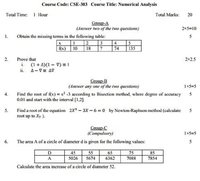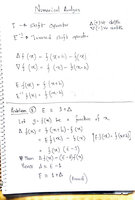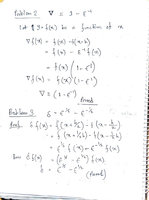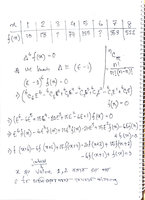looking for where can i learn this problems of numerical analysis (specifically problem 2)
- Thread starter imranmx
- Start date
HallsofIvy
Elite Member
- Joined
- Jan 27, 2012
- Messages
- 7,763
For (2) what are ∇ and Δ? How are they defined in your text book?
HallsofIvy
Elite Member
- Joined
- Jan 27, 2012
- Messages
- 7,763
Are you taking a course? Do you have a textbook? What about a teacher? "Nabla" is defined here: Nabla -- from Wolfram MathWorld .
Nabla, ∇, is a "differential operator" that, in an xy-coordinate system is ∂x∂+∂y∂ and in an xyz-coordinate system is ∂x∂+∂y∂+∂z∂.
For example, ∇f(x,y,z) where f is a scalar valued of x, y, and z is ∂x∂f+∂y∂f+∂z∂f (called "grad f", "gradient of f") and is the vector that points in the direction of fastest increase of f and has length the rate of increase (derivative) in that direction.
Or, if f=f1(x,y,z)i+f2(x,y,z)j+f3(x,y,z)k is a vector valued function the "dot product" of ∇ and f, ∇⋅f=∂x∂f1+∂y∂f2+∂z∂f3 (called "div f", divergence), measures how fast the vector functions spreads out. Finally, the cross product of ∇ and f=(∂z∂f2−∂f2∂f3∂z)i+(∂x∂f3−∂z∂f1)j+(∂y∂f1−∂x∂f2)k. The "curl" measures the rotation of the vector field.
Δ is much simpler. In introductory Calculus Δx is used to mean a small change in x. For example, the derivative of y(x) can be defined by dxdy=Δx→0limΔxΔy=Δx→0limΔxy(x+Δx)−y(x). That is, Δx is a small change in x and Δy is a small change in y, the change from y(x) to y(x+Δx).
Nabla, ∇, is a "differential operator" that, in an xy-coordinate system is ∂x∂+∂y∂ and in an xyz-coordinate system is ∂x∂+∂y∂+∂z∂.
For example, ∇f(x,y,z) where f is a scalar valued of x, y, and z is ∂x∂f+∂y∂f+∂z∂f (called "grad f", "gradient of f") and is the vector that points in the direction of fastest increase of f and has length the rate of increase (derivative) in that direction.
Or, if f=f1(x,y,z)i+f2(x,y,z)j+f3(x,y,z)k is a vector valued function the "dot product" of ∇ and f, ∇⋅f=∂x∂f1+∂y∂f2+∂z∂f3 (called "div f", divergence), measures how fast the vector functions spreads out. Finally, the cross product of ∇ and f=(∂z∂f2−∂f2∂f3∂z)i+(∂x∂f3−∂z∂f1)j+(∂y∂f1−∂x∂f2)k. The "curl" measures the rotation of the vector field.
Δ is much simpler. In introductory Calculus Δx is used to mean a small change in x. For example, the derivative of y(x) can be defined by dxdy=Δx→0limΔxΔy=Δx→0limΔxy(x+Δx)−y(x). That is, Δx is a small change in x and Δy is a small change in y, the change from y(x) to y(x+Δx).
Last edited:
i am really bad at math (really bad might be an understatement) but i want to learn
but couldn't get the courage to learn from the beginning.. because i have start from high school again.
Are you taking a course >>> yes (BSC in CSE)
Do you have a textbook >>> yes (Numerical Analysis Richard L. Burden, J. Douglas Faires, Annette M. Burden)
What about a teacher? >>> yes but too busy.... and cant access other resources because of covid.
i took some notes from class.
i understood what my teacher taught me but when it come to solve anything i just cant.
but i feel like somethings missing that i should have known from the start.
but i don't know what.
i feel so lost and the shear amount of things i have to learn just freezes me.
if i am not climbing i am falling.
but couldn't get the courage to learn from the beginning.. because i have start from high school again.
Are you taking a course >>> yes (BSC in CSE)
Do you have a textbook >>> yes (Numerical Analysis Richard L. Burden, J. Douglas Faires, Annette M. Burden)
What about a teacher? >>> yes but too busy.... and cant access other resources because of covid.
i took some notes from class.
i understood what my teacher taught me but when it come to solve anything i just cant.
but i feel like somethings missing that i should have known from the start.
but i don't know what.
i feel so lost and the shear amount of things i have to learn just freezes me.
if i am not climbing i am falling.




